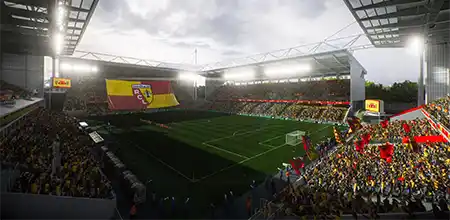Stade Bollaert-Delelis
| Official Stadium Name | Stade Bollaert-Delelis |
| Former Names | Stade Félix-Bollaert (1933–2012) |
| Alternative Names | |
| Inauguration Date | 18/06/1933 |
| Opening Game | Lens |
| Opening Game Date | 18/06/1933 |
| Attendance Record | 48912 |
| Record Match | Lens |
| Record Date | 15/02/1992 |
| Renovations | 1954, 1976, 1977, 1983, 1995-1997, 2014-2015 |
| Design | Gustave Spriet (1933) |
| Cost | €70 million (2014-2015) |
| Owner | RC Lens |
| Operator | |
| Tenants | |
| League | |
| Pitch Dimension | 105x68 meters |
| Surface | Grass |
In-Game Details
In-Game Video

Real Video
Stadium History
The stadium’s capacity exceeds the population of Lens, attracting fans from the entire region of over half a million people. RC Lens, established as a local team in the early 20th century, had to relocate twice due to resident pressure and World War I damage. By the 1920s, the club was strong enough to justify building a new stadium in the early 1930s.
The official inauguration in May featured the French and Polish anthems, reflecting the area’s significant Polish community, who also helped build the stadium under the initiative of Felix Bollaert, an executive at the French Mining Company. After Bollaert’s death in 1936, the stadium was named in his honor, with André Delelis’ name added in 2012.
Tied closely to local industry, the stadium’s fortunes rose and fell with the economy. After deteriorating in the 1960s, the stadium was transferred to the municipality, leading to major renovations in the 1970s, making it one of France’s top venues again. It hosted Euro 1984, becoming the largest stadium in France until 1998, when the Stade de France was built.
Ahead of Euro 2016, the stadium underwent further upgrades, including a new roof supported by four 72-meter-tall pylons, covering all spectators. The steep, robust stands contribute to its highly atmospheric feel, despite earlier shortcomings.

 Ligue 1
Ligue 1

 Sunny
Sunny Snow
Snow Rainy
Rainy Cloudy
Cloudy





